
Top 5 AI Tools for Email Performance Tracking
Compare AI-powered tools that boost email click-through rates by 100% and help you stand out in crowded inboxes with smarter automation.

Written by
Adam Stewart
Key Points
- Choose tools based on your needs: send time optimization vs full automation
- Track real-time analytics to protect sender reputation and maximize engagement
- Use AI personalization to cut through the 120+ daily emails your customers receive
- Focus on ROI metrics - email marketing returns $36 for every $1 spent when done right
Email marketing is one of the most effective ways to drive business results, offering an average return of $36 for every $1 spent. But with inboxes crowded by 120+ emails daily, standing out is tough. AI-powered email tracking tools simplify this challenge by providing real-time insights, automating tasks, and personalizing campaigns to boost engagement.
Here are the top 5 AI tools for email performance tracking:
- Seventh Sense: Optimizes send times using recipient behavior data, integrates with HubSpot and Marketo, and improves click-through rates by up to 100%.
- ActiveCampaign: Combines automation with real-time analytics, offering advanced segmentation and A/B testing for better engagement.
- Rasa.io: Creates highly personalized newsletters with detailed analytics to improve open and click rates.
- Copy.ai: Blends content creation with email tracking to optimize campaigns with real-time insights and automation.
- Omnisend: Tailored for e-commerce, it supports multi-channel campaigns (email, SMS, push notifications) with detailed performance tracking.
Quick Comparison:
| Tool | Key Feature | Best For | Starting Price |
|---|---|---|---|
| Seventh Sense | Send time optimization | HubSpot/Marketo users | Not specified |
| ActiveCampaign | Advanced automation + segmentation | Small to large businesses | $49/month |
| Rasa.io | Personalized newsletters | Content-focused campaigns | $500/month |
| Copy.ai | AI-driven content + analytics | Content creation + tracking | $39/month |
| Omnisend | Multi-channel (email, SMS, push) | E-commerce businesses | Not specified |
These tools help businesses automate workflows, analyze campaign performance, and personalize content for better results. Choose the one that fits your needs, whether you're optimizing send times, creating personalized newsletters, or managing multi-channel campaigns.
1. Seventh Sense
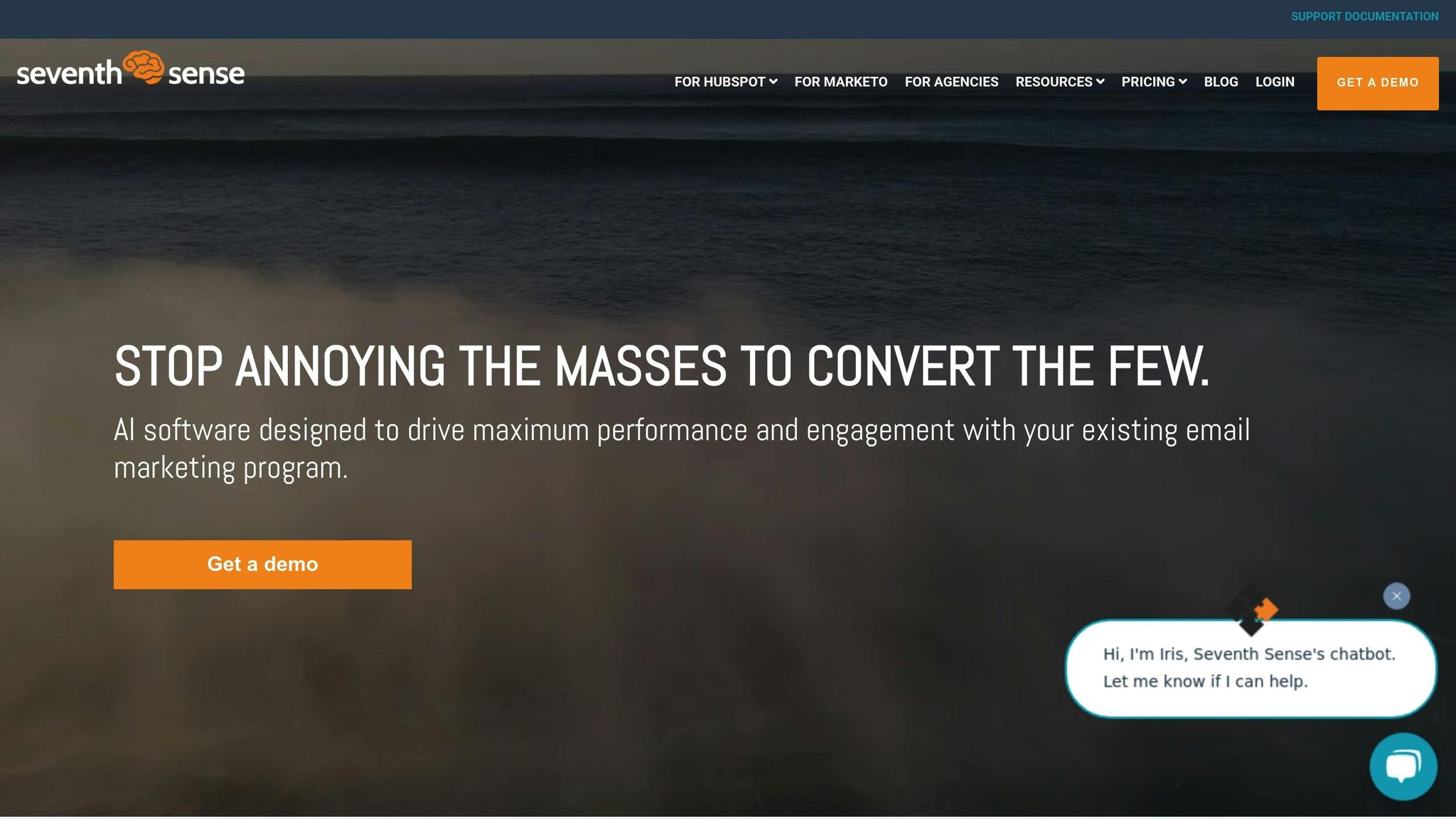
Seventh Sense is an AI-powered platform designed to boost email engagement by analyzing recipient behavior and determining the best times to send emails. With over 400 million personalized emails sent monthly through the platform, it’s a tool that scales effectively for businesses of all sizes.
Users have reported engagement improvements ranging from 7% to over 100%. By focusing on data-driven scheduling instead of fixed timelines, Seventh Sense helps organizations maximize the impact of their email campaigns.
Real-time Analytics
Seventh Sense doesn’t just optimize send times - it also delivers actionable insights through its analytics dashboard. This feature goes beyond standard metrics like open and click rates. It provides detailed insights such as engagement trends, optimal delivery times, A/B test outcomes, deliverability statistics, and sender reputation scores. These data points allow businesses to adjust their strategies on the fly, ensuring campaigns are as effective as possible.
The platform’s real-time tracking offers marketers a clear view of campaign performance as it unfolds. Thanks to its send time optimization feature, users have seen up to 100% increases in click-through rates and overall engagement.
For instance, ProAthlete, Inc. reported impressive results: a 44% reduction in email volume, doubled open and click rates, and an 11% increase in revenue.
Automation Features
The insights generated by Seventh Sense feed directly into its automation tools, enhancing campaign performance with minimal manual effort. Features like send time optimization, email throttling, and frequency control work together to protect sender reputation while improving results. The Email Frequency Optimization feature ensures recipients aren’t overwhelmed by tracking individual engagement levels.
Yonatan Lee, Founder & CEO of Insycle, highlighted the benefits of these automation capabilities:
"Love Seventh Sense! Our open rates are up, and we don't have to worry about when to send emails anymore knowing that scheduling is optimized automatically based on data...not guesses."
Seventh Sense’s AI continually analyzes recipient behavior to reduce the likelihood of emails being flagged as spam. Its Knowledge Transfer feature ensures that lessons learned from one campaign are applied to future ones, making each effort more effective than the last.
Integrations
The platform is designed to work seamlessly with HubSpot and Marketo, allowing businesses to enhance their existing marketing systems without disrupting workflows. This integration adds advanced optimization features to familiar tools, making it easier to implement AI-driven strategies.
Pricing (USD)
Although exact pricing isn’t publicly available, Seventh Sense operates on a subscription model that adjusts based on usage. As an enterprise-level solution, it’s most suitable for organizations with high email marketing volumes that can justify the cost through increased engagement and revenue.
The platform has received glowing reviews, earning 5.0/5 stars on both Capterra and GetApp. Users frequently highlight its ability to improve open rates and deliverability, though some have noted that the initial setup process can be challenging. Will Angel, Marketing Data Analyst at Knowledge To Practice, summarized its value:
"By reaching people when they are more likely to engage, we increase the odds of them not just opening, but clicking and going deeper into our marketing funnel."
2. ActiveCampaign
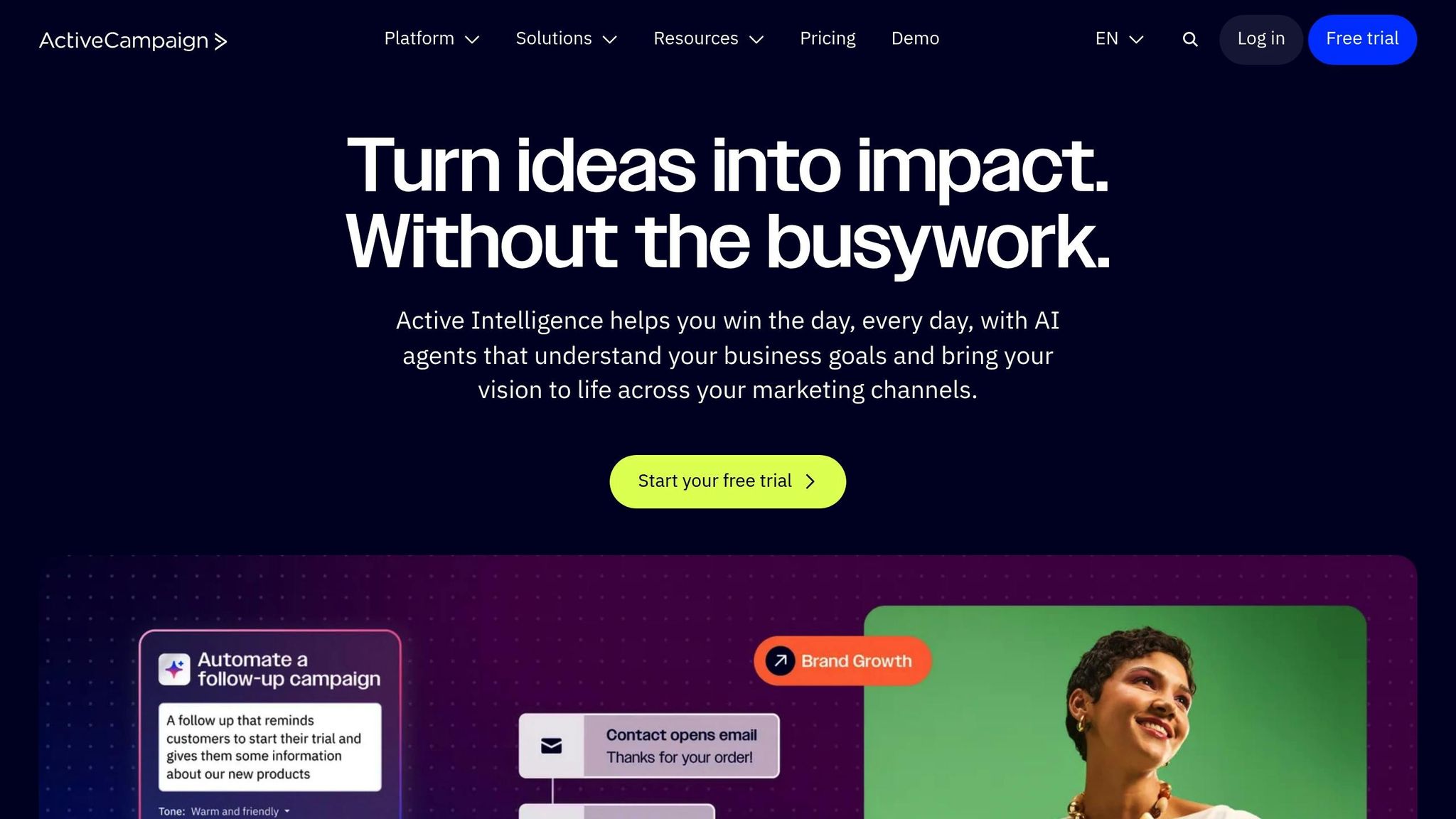
ActiveCampaign blends AI-driven automation with detailed performance tracking to help businesses fine-tune their email campaigns. By integrating real-time insights with automation, it empowers users to boost email performance effectively. With an impressive overall rating of 4.6/5 stars, the platform enables businesses to monitor engagement patterns and automate responses based on subscriber behavior. Companies leveraging its segmentation tools have reported up to 30% higher open rates compared to industry benchmarks. Additionally, personalized email sequences, powered by dynamic content, have shown a 15–25% improvement in click-through rates.
Real-time Analytics
ActiveCampaign provides real-time analytics that track key metrics such as open rates, click-through rates, bounces, unsubscribes, and conversions. It also monitors trends across email clients, deals, contacts, and chat interactions.
The send time analysis feature is particularly useful, offering insights into performance across different days and times to help identify the best windows for sending emails. For instance, YMCA utilized behavioral trigger emails to tag contacts after they clicked on program links, achieving a remarkable 12.8% click-through rate - far above the industry average of 2%.
Companies using ActiveCampaign's A/B testing tools have seen average conversion rate improvements of 8–12% within just three months. These analytics provide valuable data to refine automation strategies.
Automation Features
ActiveCampaign’s automation tools transform how businesses manage email engagement. Features like Engagement Tagging automatically add or remove tags based on how contacts interact with emails or websites, ensuring healthier email lists and better deliverability. Businesses can also assign scores to contacts based on specific actions. For example, clicking a link in a 1:1 email can increase a contact’s score by 15 points using an automation recipe.
Success stories highlight the platform’s impact. Your Therapy Source generated 30% of its revenue from abandoned cart email automations, achieving a staggering 2000% ROI. Meanwhile, Paperbell saw an 8–10% revenue increase and reduced customer onboarding time by 35%.
Integrations
ActiveCampaign supports over 300 native integrations, seamlessly connecting with tools like Salesforce, WooCommerce, Shopify, WordPress, Slack, Calendly, Zapier, and Google Analytics. Its robust API further enhances its ecosystem, allowing businesses to integrate email performance data with other marketing and analytics platforms. Through Zapier, users gain access to thousands of additional tools.
Specialized reporting tools, such as those from AgencyAnalytics, simplify complex data by integrating with over 80 marketing channels to create client-friendly reports.
Pricing (USD)
ActiveCampaign offers tiered pricing tailored to contact count and feature needs. These plans cater to both small businesses and enterprise-level operations, starting at budget-friendly rates. While some users have noted occasional deliverability issues, such as emails landing in spam folders, the platform’s overall functionality rating of 4.5/5 underscores its strength in email marketing automation and analytics.
A user shared, "ActiveCampaign is a great tool for email automation and customer engagement. It is very easy to set up and has some powerful features, yet can be tricky for beginners".
3. Rasa.io
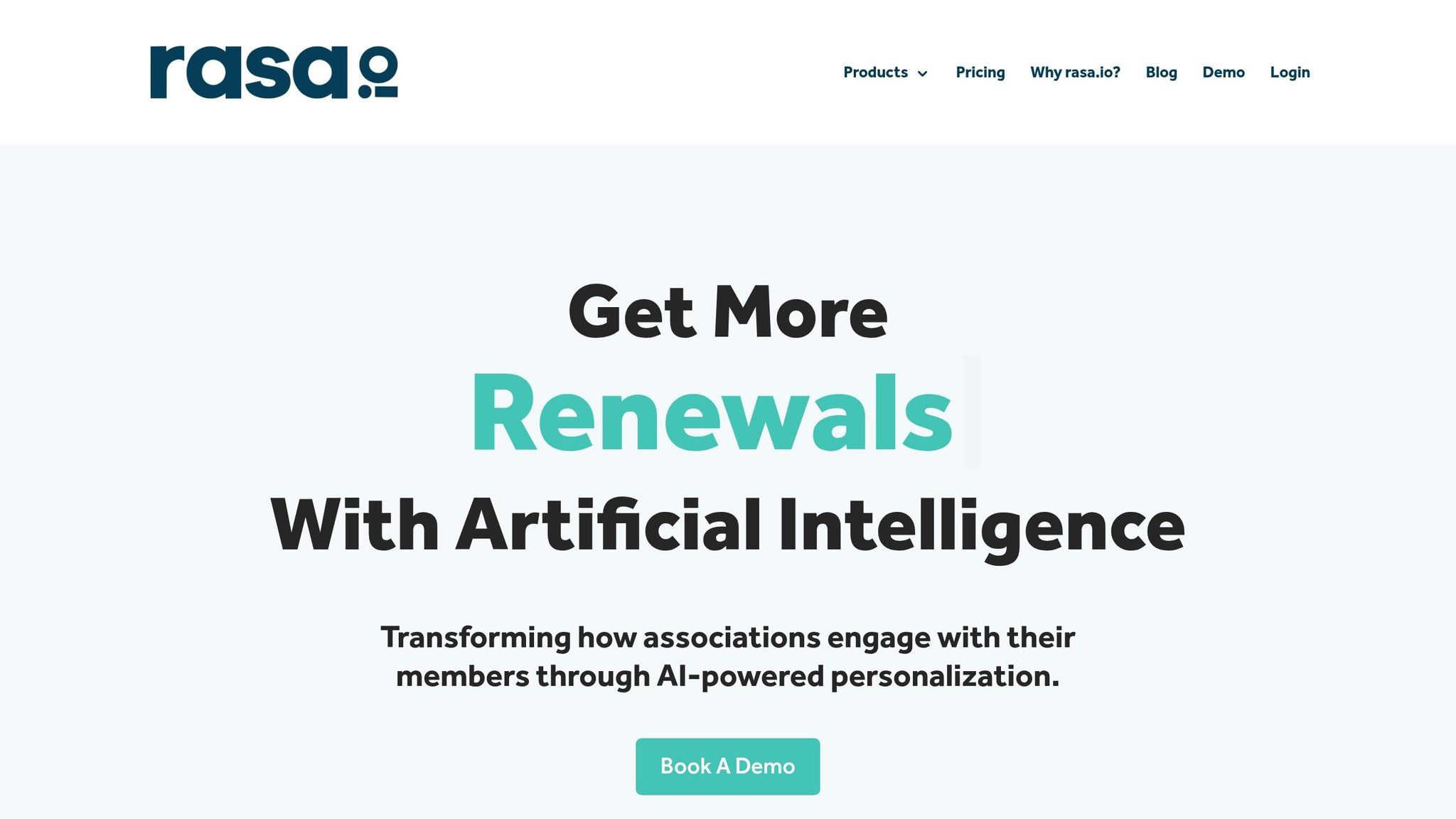
Rasa.io is an AI-driven newsletter platform known for its ability to deliver engagement rates up to three times higher than traditional methods. By harnessing artificial intelligence, it crafts personalized newsletters tailored to the unique interests of each subscriber. The platform also provides detailed, real-time performance tracking to help marketers fine-tune their strategies.
Real-time Analytics
Rasa.io goes beyond standard metrics like open and click rates, offering in-depth insights into subscriber behavior. One standout feature, "Today's Newsletter Info", tracks hourly opens and clicks, helping users identify peak engagement times.
Marketers can filter top-performing articles by various time frames, such as monthly, weekly, daily, or even custom date ranges. This flexibility allows them to spot trends and better understand audience preferences. Additionally, the platform analyzes the effectiveness of AI-generated subject lines, highlighting which ones drive the most opens and clicks, aiding in subject line optimization.
The updated sources analytics page adds another layer of detail, offering metrics on conversion rates for individual content sources. This information helps businesses make smarter decisions about content curation, using real-time data to enhance their newsletters' personalization and impact.
Automation Features
Rasa.io's AI takes personalization to the next level by curating content based on subscriber engagement patterns. It monitors individual subscriber behavior - like past opens and clicks - and adjusts delivery times accordingly. This ensures that each recipient gets content aligned with their preferences, boosting engagement.
The platform continually learns from subscriber interactions, refining its recommendations and timing to keep improving results. These insights allow marketers to adjust their strategies based on actual performance data rather than guesswork. On top of that, Rasa.io integrates seamlessly with key business tools, making it an efficient choice for email marketing.
Integrations
Rasa.io connects with major CRM and automation platforms, including HubSpot, Mailchimp, and Salesforce. It also integrates with tools like Integrately, Pabbly Connect, Pipedream, Syncspider, and Zapier.
The HubSpot integration has proven especially impactful. For example, a transportation and storage company reported that using Rasa.io with HubSpot consistently generated consultation requests, leading to high-value prospects and increased sales.
"Rasa helps generate high quality newsletters which can be targeted to key market segments utilizing far less resources than any other method you can dream of. Utilizing the Rasa AI allows us to segment our market's segments better than we could ever hope for. With the HubSpot integration, these micro-segment markets are then 'rained on' with targeted workflow emails to direct them further down in our sales funnel. The value to cost ratio is unequalled." - Romaine, E., Transportation & Storage
In the education sector, users have highlighted how the integration provides detailed insights into individual audience interests, especially when newsletters pull content from multiple sources. Similarly, a marketing professional praised the ease of use and the ability to bring valuable audience data back into HubSpot for further analysis, workflows, and automation.
Pricing (USD)
Rasa.io offers a range of pricing plans to suit different business needs. The Basic plan is priced at $500 per month for organizations with annual revenue under $10 million. The Plus plan costs between $190 and $490 per month, depending on the number of contacts (5,000–20,000). For larger organizations, the Pro plan starts at $490 per month for 10,000 contacts and scales up to $3,490 per month for 200,000 contacts.
For Enterprise customers, there’s a one-time setup fee of $5,000. Annual fees start at $12,000 for newsletters or $10,000 for campaigns. These pricing tiers reflect the platform’s advanced analytics and automation capabilities, which are designed to maximize the impact of targeted email campaigns.
4. Copy.ai
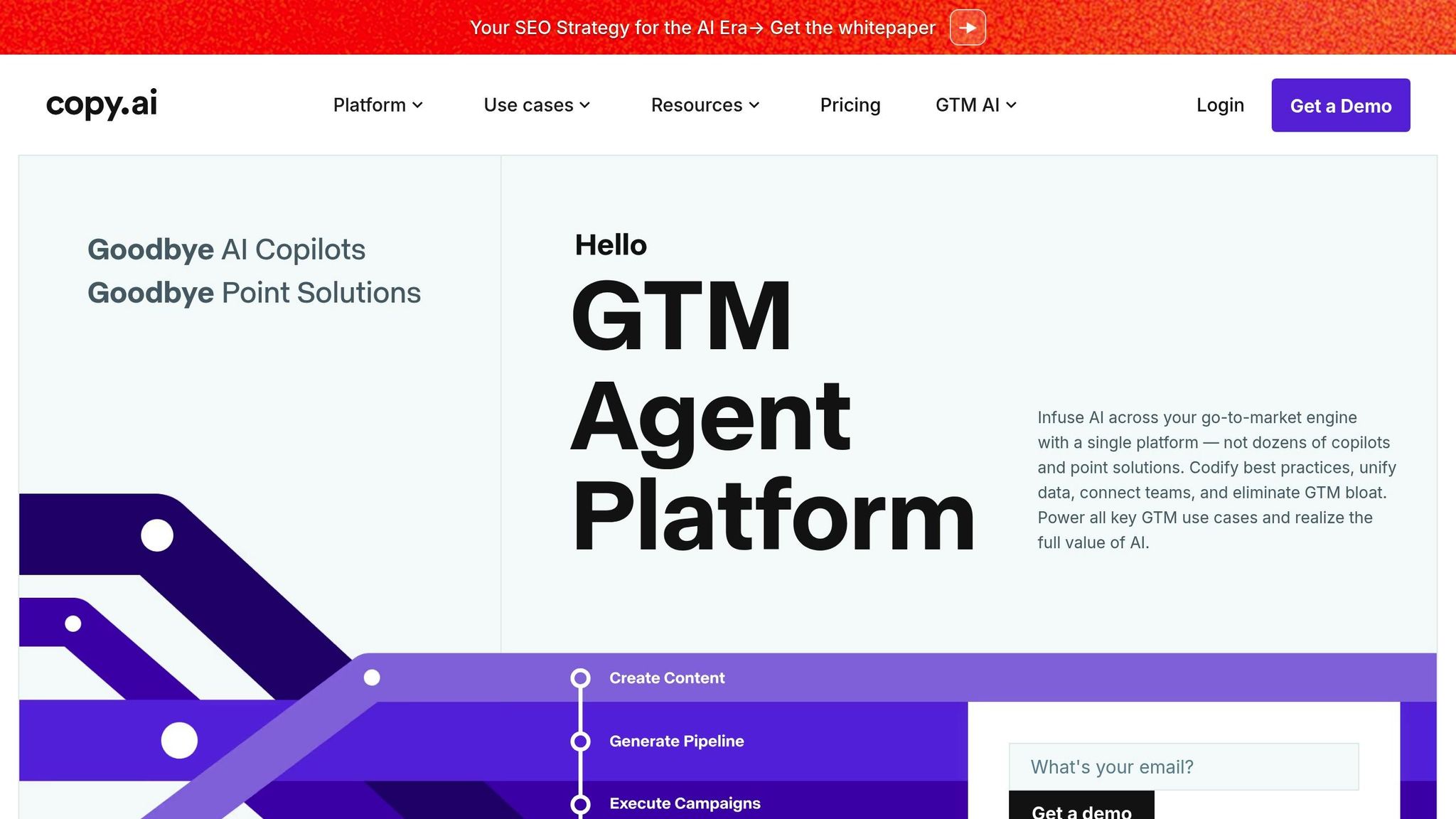
Copy.ai is an AI-driven platform that combines content creation with real-time email tracking through its GTM AI Platform. While it’s primarily recognized for generating content, the platform has expanded to offer tools that help businesses monitor and fine-tune email campaigns using real-time insights and automation. This integration of creative and analytical capabilities allows marketers to optimize their campaigns as they unfold.
Real-time Analytics
Copy.ai’s email tracking features deliver instant insights into critical metrics like email opens, clicks, and downloads. These real-time updates enable marketers to act at the right moment and adjust their strategies based on live data. For example, the platform highlights that emails with personalized subject lines see a 26% higher open rate. By providing actionable analytics, Copy.ai ensures campaigns stay on track and achieve better engagement.
Automation Features
The platform simplifies email marketing by automating workflows, which often results in higher open and click-through rates. It can automatically segment email lists and personalize entire campaigns - from subject lines to the email body - while continuously optimizing sender reputation and deliverability. Users can also set dynamic rules for hyper-personalization, ensuring every recipient gets content tailored to their preferences. These automation tools work hand-in-hand with real-time tracking, offering flexibility and adaptability for marketers.
Integrations
Copy.ai connects with over 2,000 tools via Zapier, integrating seamlessly with platforms like Google Docs, Sheets, WordPress, Buffer, Shopify, Slack, HubSpot, and Airtable. These integrations make it easier to share data between Copy.ai and other marketing tools, enhancing email performance tracking across multiple channels. For example, Juniper Networks reported generating five times more meetings through its AI-powered strategy. Similarly, Roman Olney, Lenovo's Head of Global Digital Experience, shared that Copy.ai saved the company $16 million in 2024 by automating workflows that previously required weeks of manual effort and high agency costs.
"Thanks to Copy.ai, we're generating 5x more meetings with our personalized, AI-powered GTM strategy."
- Jean English, Chief Marketing Officer, Juniper Networks
"Copy.ai has been phenomenal in transforming the way we develop marketing content. By automating workflows that would typically take weeks and cost thousands of dollars through agencies, they've saved us $16 million this year alone."
- Roman Olney, Head of Global Digital Experience, Lenovo
sbb-itb-ef0082b
5. Omnisend
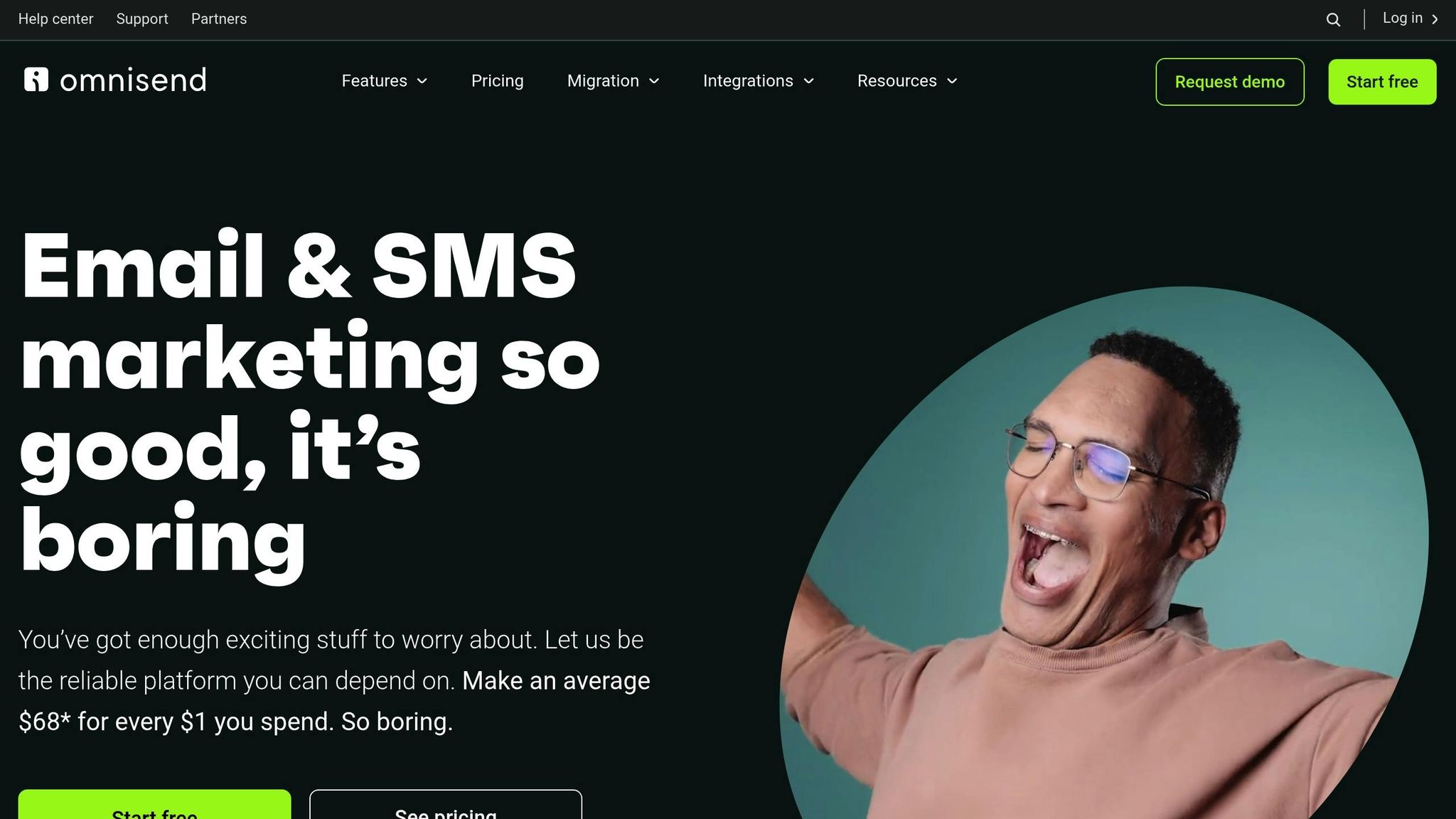
Omnisend is an email marketing platform tailored for e-commerce businesses, offering real-time performance tracking and multi-channel automation. It allows users to manage email campaigns, SMS, and web push notifications all from a single dashboard. With its advanced tools, Omnisend helps online retailers boost revenue. Let’s dive into its standout features, including analytics, automation, integrations, and pricing.
Real-time Analytics
Omnisend provides detailed, real-time insights into how subscribers interact with campaigns. It tracks key metrics like open rates, click rates, and sales generated from emails, with users seeing an impressive 45% open rate on average. Its Clickmap tool pinpoints exactly where subscribers click within emails, helping marketers refine their content. Additionally, hourly reports during the critical first 24 hours of a campaign offer immediate performance updates.
The platform also includes tools to address deliverability issues, monitor sender performance, and maintain clean email lists. Form reports further help businesses analyze audience growth. For example, B-Wear, a client of Omnisend, achieved impressive results:
"The data we've gotten from Omnisend has been super beneficial, netting us nearly $8,000 in sales for an average email campaign."
- Lauren Rose, Email and Social Media Marketing Manager at B-Wear
Automation Features
Omnisend’s automation tools are designed to simplify multi-channel marketing. With pre-built workflows and an intuitive drag-and-drop editor, users can create campaigns that combine email, SMS, and web push notifications into a cohesive customer journey. These automated workflows are highly effective, driving 37% of sales, with 52% higher open rates and 332% more clicks compared to scheduled emails. Remarkably, one in three recipients who click on an automated message make a purchase, compared to one in 18 for scheduled messages.
FiGPiN, another Omnisend client, shared their success with automation:
"We see amazing results from our automated emails. Our cart abandonment especially stands out with an 87% conversion rate and $7.44 revenue per email."
- Allison Caufield, Senior Marketing Manager at FiGPiN
The platform supports various automation types, including welcome series, cart abandonment, browse abandonment, order confirmations, and cross-sell campaigns. Abandoned cart emails alone drive significant results, with welcome and browse abandonment emails accounting for 87% of all automated orders. Overall, automations contribute to 30% of Omnisend’s total sales.
Integrations
Omnisend makes it easy to connect with other tools, offering over 160 pre-built integrations along with flexible APIs. It seamlessly integrates with popular e-commerce platforms like Shopify, WooCommerce, Magento, and OpenCart. Additionally, it connects with advertising platforms like Facebook and Google, enabling businesses to create retargeting campaigns. These integrations allow for custom workflows that incorporate data from loyalty programs, help desks, review systems, and shipment tracking services. For instance, Black Mango saw a 150% increase in newsletter signups within just four weeks using Omnisend’s email capture features.
Pricing (USD)
Omnisend’s pricing is designed to be scalable and appealing, especially for businesses leveraging multiple marketing channels. Vape Superstore highlighted the platform’s affordability:
"What we were paying just for email at Klaviyo is nearly the same as what we're paying Omnisend for both email & SMS."
- Dan Judd, Head of Digital at Vape Superstore
With its combination of competitive pricing and powerful features, Omnisend is an excellent option for businesses looking to enhance their email marketing efforts.
Advantages and Disadvantages
Let’s take a closer look at the pros and cons of these AI-powered email performance tracking tools. Each platform brings something unique to the table, but they also have their limitations.
| Tool | Key Strengths | Main Weaknesses | Starting Price |
|---|---|---|---|
| Seventh Sense | Uses behavior profiling to determine optimal send times. Deep integration with HubSpot and Marketo. | Limited compatibility with other platforms; focuses primarily on send time optimization. | Not specified |
| ActiveCampaign | Advanced AI automation, including predictive sending and detailed segmentation. | Higher starting cost at $49/month. | $49/month |
| Rasa.io | Excels in personalized content curation and newsletter automation. | Lacks broader email marketing features; its niche focus may not suit all businesses. | Not specified |
| Copy.ai | Strong AI capabilities for generating scalable, on-brand email content. | Requires human oversight for accuracy; fewer analytics features compared to full platforms. | $39/month |
| Omnisend | Offers a multi-channel approach (email, SMS, push notifications) with a focus on e-commerce. | - | Not specified |
Across the board, these tools shine in automating repetitive tasks, which is a huge time-saver. In fact, research shows that 52% of marketers using AI tools report faster and more efficient workflows. With 61% of businesses now leveraging AI to optimize email campaigns, this automation has become a key driver of productivity.
However, there are some common drawbacks. Many platforms fall short in providing deep strategic insights or robust data privacy measures. They often rely on standard features, which can make it hard to stand out from competitors.
Integration capabilities and pricing structures vary widely, reflecting different approaches to value and trade-offs. Still, the benefits are clear: AI-powered email marketing has been shown to boost click-through rates by 13% and increase revenue by 41% compared to traditional methods.
Accuracy is another critical factor. The effectiveness of AI tools depends heavily on clean, reliable data. Regularly auditing AI-generated content ensures that it aligns with your brand and remains accurate, while maintaining oversight in decision-making helps reduce the risks of over-relying on automation.
Ultimately, the key to success lies in choosing a tool that aligns with your specific business goals. Whether your focus is on driving sales, improving engagement, or strengthening brand loyalty, it’s essential to evaluate features like personalization, automation capabilities, predictive analytics, and integrations in the context of your needs.
These considerations provide a roadmap for businesses looking to select the right AI tool to elevate their email marketing efforts.
Conclusion
Selecting the right AI tool comes down to understanding your business's size and specific needs. For smaller businesses, tools that simplify and automate routine tasks are often the best fit. On the other hand, larger enterprises benefit from platforms that offer scalability, strong collaboration features, and advanced security measures. Tools like ActiveCampaign and Seventh Sense stand out in enterprise settings, providing features such as scalable inbox management, enterprise-level security compliance, and team collaboration tools that streamline coordination across departments.
The impact of these tools is clear when looking at measurable campaign results. AI-powered email monitoring has been a game-changer for U.S. businesses, driving higher response rates, improved open rates, and stronger ROI. Consider this: email marketing generates an average return of $42 for every $1 spent, showcasing its ability to significantly boost revenue.
"Your job will not be taken by AI. It will be taken by a person who knows how to use AI", says Christina Inge, Instructor at Harvard Division of Continuing Education's Professional & Executive Development.
To maximize ROI, start by choosing tools that align with your budget and capabilities. Begin with one platform and expand as you see results. Pay close attention to metrics like open rates, click-through rates, and conversion rates to gauge the effectiveness of your campaigns. These metrics highlight the strategic advantages of integrating AI into email marketing.
As discussed, successful implementation depends on quality data and ongoing human oversight. Regularly reviewing AI-generated content ensures accuracy and relevance. Each tool offers unique strengths - Seventh Sense excels in behavioral profiling, while ActiveCampaign shines with its robust automation features. Despite their differences, both tools transform customer data into actionable insights that can drive meaningful business outcomes.
As AI technology advances, businesses that adopt these tools now will be better equipped to leverage future innovations and maintain a competitive edge in their email marketing strategies.
FAQs
How can AI tools improve email marketing performance compared to traditional methods?
AI tools are changing the game in email marketing, making campaigns smarter and more tailored than ever before. They boost open rates by crafting subject lines and content that match individual preferences, fine-tune send times based on user activity, and drive engagement through dynamic personalization. The result? Better email deliverability and increased revenue.
On top of that, AI processes massive amounts of data in real time, helping businesses create more precise and effective strategies. Marketers have found that AI-powered email campaigns outperform traditional ones, showing higher click-through rates and conversions. By automating repetitive tasks and offering actionable insights, AI tools allow businesses to build stronger, more meaningful connections with their audience.
What should businesses look for when selecting an AI tool to track email performance?
When choosing an AI tool to monitor email performance, it's essential to zero in on features that matter most. Look for real-time analytics, seamless integration with your existing systems, and data security compliance to safeguard sensitive information. These capabilities ensure you can track key metrics like open rates, click-through rates, and overall engagement effectively.
It's also important to evaluate the tool's user-friendliness, scalability, and customization options to align with your specific business needs. Finally, partnering with a vendor known for reliability, a strong track record, and responsive customer support can make a big difference in maximizing your investment.
How do AI email tracking tools work with platforms like HubSpot and Salesforce?
AI-driven email tracking tools work effortlessly with platforms like HubSpot and Salesforce, thanks to built-in features or APIs. These integrations make it easy to automatically sync contact details, track when emails are opened or clicked, and monitor campaign performance as it happens.
Some tools also allow businesses to create automated, personalized email campaigns directly within these platforms. This not only boosts marketing efficiency but also provides valuable insights by keeping all your email performance data in one place, making it easier to analyze and act on.
Summarize with AI
Related Posts
Checklist for Choosing AI Email Tools
Streamline your email marketing with AI by using this comprehensive checklist to choose the right tools for your business needs.
AI-Powered Email Personalization: Best Practices
Unlock the potential of AI-driven email personalization to boost engagement, enhance customer connections, and maximize ROI through tailored messaging.
AI Email Personalization: How It Works
Learn how AI email personalization enhances customer engagement through tailored content, optimizing send times, and improving metrics for businesses.
Top AI Tools for Personalized Customer Service
Explore how AI tools enhance personalized customer service for SMBs, from chatbots to email marketing, while saving costs and improving efficiency.
